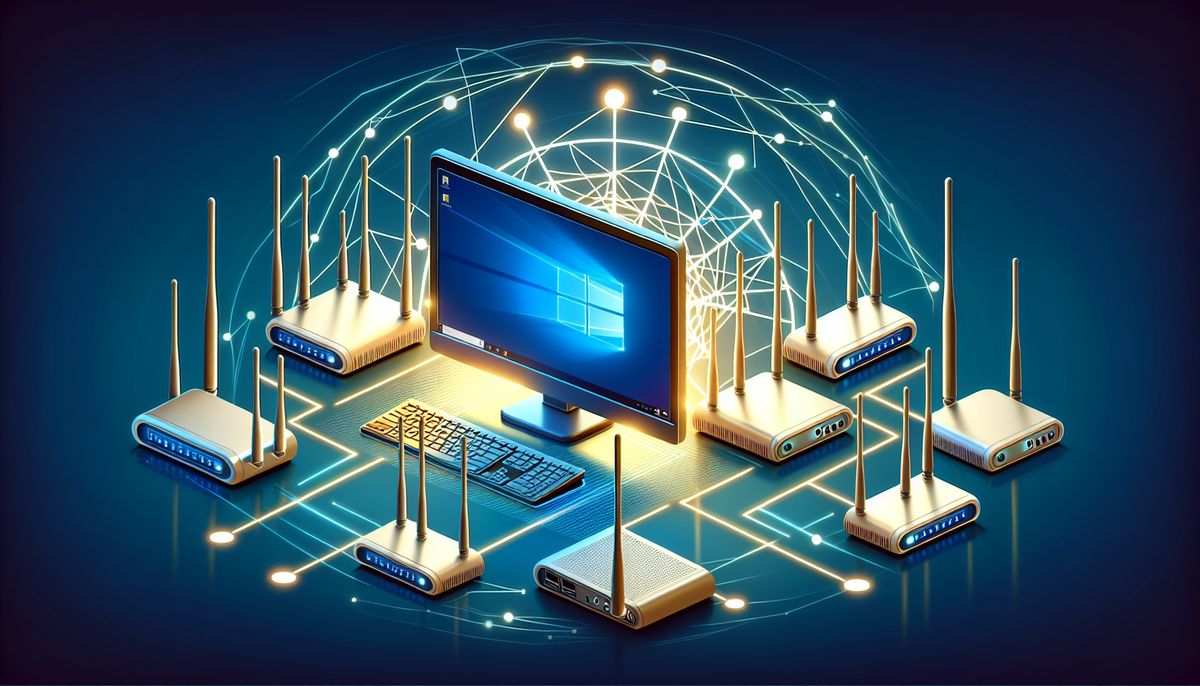Networking with routers using Windows 11 can be a straightforward process if you know the right steps to take. This article will guide you through setting up your network, connecting to Wi-Fi networks, configuring your router for optimal performance, sharing resources, and extending your network with secondary routers and access points. With an emphasis on practical advice and troubleshooting tips, you’ll be well-equipped to create a robust and efficient network environment.
Key Takeaways
- Understanding the different network types and configuring network discovery options are crucial for setting up your network on Windows 11.
- Adding Wi-Fi networks manually and managing Wi-Fi profiles helps ensure a seamless wireless experience, while setting up a metered connection can save on data costs.
- Accessing the router configuration interface and adjusting DNS and DHCP settings are key to optimizing router performance and network stability.
- Enabling file and printer sharing and managing homegroups or other sharing options allows for efficient resource distribution across different Windows versions.
- Using secondary routers as access points and implementing network segmentation can expand coverage and enhance network security.
Setting Up Your Network on Windows 11
Choosing the Right Network Type
When we’re setting up our network on Windows 11, picking the right network type is crucial for a smooth experience. We want to ensure all our devices can connect using the fastest radio mode they support. This means enabling every mode your router offers, which not only accommodates older devices but also minimizes interference from nearby networks.
Here’s a quick rundown on what to consider:
- Bands: Enable all bands your router supports to maximize data capacity and performance.
- Channel: Set to Auto for the router to select the best channel, reducing Wi-Fi interference.
- Smart Connect: If available, this feature simplifies your network by combining all bands under one Wi-Fi name, assigning the fastest connection to each device.
In cases where Smart Connect isn’t ideal, such as with older devices that struggle with the 5GHz band, it might be better to manage your bands separately to avoid congestion.
Remember, if you’re integrating the router into an existing wired network, consider setting it to AP mode to let your existing network manage connections, which can simplify your network management and improve connectivity for activities like gaming.
Configuring Network Discovery Options
When we’re setting up our network on Windows 11, we want to make sure that all our devices can see each other. This is where network discovery comes into play. It’s a setting that allows your computer to find other devices and computers on the same network, and it lets them find you too. Here’s how we can configure it for different network types:
- Private networks: Turn on network discovery and file and printer sharing to allow easy access to local resources.
- Public networks: Keep these options off to protect your PC on more vulnerable networks, like those in coffee shops or airports.
- All networks: Consider turning on public folder sharing and using 128-bit encryption to protect file sharing.
It’s crucial to ensure that network discovery settings align with the network type you’re connected to. This keeps your devices visible to each other on safe networks, while maintaining your privacy and security on public ones.
By tweaking these settings, we can help our computers and devices communicate more effectively. And don’t worry about password-protected sharing; turning it off can simplify the process without compromising security, as long as you’re on a private network. Stay secure with Omaha Computing Solutions.
Troubleshooting Visibility of Computers on the Network
We’ve all been there, trying to get our Omaha computers to see each other on the network, and it’s just not happening. It can be maddening, especially when you’re using computers Omaha relies on for daily operations. Sometimes, the issue might be as simple as a setting that needs tweaking. Here’s a quick checklist to help you troubleshoot:
- Ensure all computers are set to ‘Private network’ with network discovery and file and printer sharing turned on.
- Check if your router settings are consistent across devices. This includes DNS and DHCP configurations.
- Run network scanning tools like NMAP or AIP scanner to verify open ports and shares.
If you’ve gone through these steps and still face issues, it might be time for a deeper dive. A reset of Windows 11 could be in order, but remember to back up your data first. For those tough cases, don’t hesitate to reach out to us at Omaha Computing Solutions. We’re here to help with your used desktops Omaha, used laptops Omaha, and even refurbished computers.
Sometimes, the solution is a fresh start. If you’re considering a reset, our guide to resetting Windows 11 via Settings, Command Prompt, or boot with USB drive is a handy resource. And for those refurbished desktop computers and computer monitors that just won’t cooperate, we’ve got troubleshooting tips and when to reset covered.
Connecting to Wi-Fi Networks
Manually Adding Wi-Fi Networks
Sometimes, you’ll need to manually connect to a Wi-Fi network, especially if the SSID isn’t broadcasted. We’ve got you covered with a simple guide to get you connected. First, click on the Wi-Fi icon in the taskbar and select ‘Network & Internet settings’. Then, navigate to Wi-Fi and click on ‘Manage known networks’. Here, you can ‘Add a network’ by entering the SSID and selecting the security type.
It’s crucial to ensure your network is secure. Opt for the highest level of security available, typically WPA3. If your router supports it, enable automatic firmware updates for enhanced performance and stability.
Lastly, don’t forget to adjust your connection properties. If you’re on a limited data plan, set the network as metered. This will help manage data usage on your Windows 11 device. Here’s a quick rundown:
- Click Wi-Fi icon in taskbar
- Go to ‘Network & Internet settings’
- Select ‘Manage known networks’
- Click ‘Add a network’, enter SSID
- Choose security type, preferably WPA3
- Set as metered if necessary
Managing Wi-Fi Profiles
We’ve all been there, trying to declutter our Wi-Fi list on our Windows 11 devices. It’s essential to manage your Wi-Fi profiles effectively to ensure a smooth and secure connection. Managing your Wi-Fi profiles is a breeze on Windows 11. You can view, prioritize, and forget networks that you no longer use.
To get started, simply go to your Wi-Fi settings and click on ‘Manage known networks.’ Here’s a quick rundown of what you can do:
- View your saved networks
- Prioritize networks by dragging and dropping them in the list
- Forget networks that you no longer need
This keeps your connection priorities straight and avoids the hassle of accidentally connecting to less preferred networks. Plus, it’s a good security practice to forget networks that are no longer in use.
By keeping your Wi-Fi profiles tidy, you’re not just organizing your network connections, you’re also bolstering your device’s security and performance.
Remember, a well-managed Wi-Fi profile list means fewer headaches and a better networking experience overall.
Setting Up a Metered Connection
After you’ve got your Wi-Fi network up and running, you might want to consider setting up a metered connection. This is especially handy if you’re on a limited data plan. Windows 11 makes it easy to control your data usage by allowing you to designate a Wi-Fi network as metered.
Here’s how to do it:
- Open the ‘Settings’ app and go to ‘Network & Internet’.
- Click on ‘Wi-Fi’ and then select the network you want to set as metered.
- Scroll down to ‘Metered connection’ and switch the toggle to ‘On’.
By setting a network as metered, you’re telling your computer to hold back on certain tasks that can eat up your data, like downloading updates or syncing large files.
Remember, while this can help keep your data usage in check, it’s not a silver bullet. Some apps might still use more data than you expect, so keep an eye on your usage. And if you’re looking for a networking product with PoE+ port, Gigabit Ethernet, Layer 2 support, and various features, we’ve got you covered. Our solutions are ideal for high-speed data transfer and secure business operations.
Configuring Router Settings for Optimal Performance
Accessing Router Configuration Interface
We’ve all been there, sitting with our computer mouse in hand, ready to dive into the router’s settings. It’s time to get our hands dirty and tweak our network to perfection. Most routers offer a user-friendly interface, similar to a website or app, making it easy for us to navigate through the various settings.
To start, you’ll need to access the router’s configuration page. This is usually done by entering the router’s IP address into your web browser’s address bar. Here’s a quick rundown of the steps:
- Make sure your computer is connected to the router’s network.
- Open your web browser.
- Type in the router’s IP address (commonly
192.168.1.1or192.168.0.1). - Enter the default admin username and password (often found on the router or in its manual).
Once you’re in, the first thing you should do is set a new admin password to secure your network.
Remember, if you’re unsure about any settings, the router’s manual is your best friend. It’s packed with helpful information tailored specifically for your model. And if you’re on the go, consider using the router’s mobile app for a more convenient experience.
Adjusting DNS and DHCP Settings
When we’re setting up our network, it’s crucial to get the DNS and DHCP settings just right. DNS (Domain Name System) is like the phonebook of the internet, translating domain names into IP addresses so our devices can access websites smoothly. By default, routers use the DNS server provided by the ISP, but we can switch to a different one if needed for faster or more secure browsing.
For DHCP (dynamic host configuration protocol), it’s the gatekeeper, assigning IP addresses to devices on our network. It’s important to have only one DHCP server active to avoid address conflicts. If you’ve got both a cable modem and a router, make sure DHCP is enabled on just one. Here’s a quick rundown of DHCP lease time recommendations:
- Home or office networks: Set to 8 hours
- Hotspots or guest networks: Set to 1 hour
Adjusting these settings can significantly impact your network’s performance and reliability, so take the time to get them dialed in just right.
Creating Multiple Wireless Networks
We at Omaha Computing Solutions understand the need for versatility in your home network. That’s why we’re excited about routers that let you create multiple wireless networks. This feature is perfect for setting up a guest or IoT network, ensuring that your main network stays secure and uncluttered.
Here’s a quick guide on how to get started:
- Access your router’s configuration page, usually found at an IP address like 192.168.1.1.
- Use the same network name (SSID) across all bands (2.4 GHz, 5 GHz, 6 GHz) to ensure device compatibility.
- Choose a unique SSID for your network to avoid confusion with neighboring networks.
- Consider the number of other wireless networks in your area to select a less congested band.
When setting up multiple networks, it’s crucial to maintain consistent naming across bands. This helps devices like Apple products that support Wi-Fi 6E to recognize and connect to your network without issues.
Remember, creating separate networks for guests and smart home devices not only improves security but can also enhance performance by reducing interference.
Sharing Resources Over the Network
Enabling File and Printer Sharing
We’ve all been there, trying to print that urgent document or access a shared folder, only to realize file and printer sharing isn’t set up. Enabling file and printer sharing on Windows 11 is a breeze, and it’s crucial for a smooth workflow in our office networks. Here’s how we do it:
- First, we ensure our network is set to ‘Private’ because that’s the safer option for sharing within a trusted network.
- Next, we turn on ‘Network discovery’ and ‘File and printer sharing’ in our network settings. This allows our computers to see each other and share resources like computer printers.
- For ‘Public networks,’ we keep these settings off to protect our data from prying eyes.
It’s important to note that while sharing resources, we must maintain security. Avoid settings like ‘None,’ ‘Open,’ or ‘Unsecured,’ as they can expose our network to unauthorized access.
Lastly, we double-check our settings to ensure everything is in order. Here’s a quick rundown of what our settings should look like:
| Network Type | Network Discovery | File and Printer Sharing |
|---|---|---|
| Private | ON | ON |
| Public | OFF | OFF |
With these steps, we’ll have our computer printers and shared folders up and running in no time, making our office life a whole lot easier.
Setting Up and Managing Homegroups
When we’re looking to share resources like files and printers across our Windows 11 network, setting up Homegroups used to be the go-to method. However, it’s important to note that Homegroups have been removed starting with Windows 10 version 1803. But don’t worry, we’ve still got plenty of options to share our resources effectively.
We can map network drives using the NET USE command to ensure a stable and reliable connection to shared folders. This method involves creating a simple batch file on the desktop with the necessary script to map the desired folder to a drive letter. Here’s a quick guide on how to do it:
- Create a
.batfile with the script:NET USE Z: \\Computer\Drive or Folder /user:username pwd(username and password are optional). - Repeat the process for each drive you want to map.
- To disconnect, make a
Disconnect.batfile with the script:NET USE Z: /Delete. - Use
gpedit.mscto add these scripts to the User Configuration under Windows Settings for automatic connection and disconnection on logoff.
By taking these steps, we ensure that every time we sign out, restart, or shut down, our network connections are cleanly disconnected, making our next login smoother and more reliable.
Additionally, to optimize Windows performance and get the most out of our networking capabilities, it’s crucial to keep our system clean, updated, and free from unnecessary features. Regular maintenance, including defragmenting the hard disk, can lead to better efficiency and responsiveness, which in turn enhances our networking experience.
Network Sharing for Different Windows Versions
When it comes to network sharing, Windows has evolved over the years, offering different methods to share resources across various versions. We’ve got you covered, whether you’re running an older version like Windows 7 or the latest Windows 11.
For instance, Windows 7 users might remember setting up network sharing with the ‘Homegroup’ feature, which was a straightforward way to share files and printers. However, starting with Windows 10, ‘Homegroup’ was removed, and the focus shifted to using different settings for private and public networks.
Here’s a quick rundown of the settings you should check for private and public networks:
- Private networks: Network discovery ON, File and printer sharing ON
- Public networks: Both options OFF
Additionally, for all networks, consider turning on public folder sharing and setting file sharing to 40- or 50-bit encryption for added security. Password-protected sharing can be turned off if you want easier access within a trusted network.
If you’re experiencing issues with visibility of computers on your network, make sure all devices are set to the same workgroup and that network discovery and file sharing options are correctly configured.
Remember, networking can sometimes be finicky, and it’s not uncommon to run into visibility issues even when all settings seem correct. Tools like NMAP and AIP scanner can help diagnose the problem by checking shares, open ports, and more. And if you’re looking for a reliable connection, consider using scripts to log off connections on sign out, which can help stabilize your network environment.
Lastly, don’t forget that a good network setup isn’t just about software settings. Hardware can play a crucial role too. For example, a USB 3.0 Ethernet Adapter with 3 USB ports can significantly enhance your data transfer speeds, and it’s plug and play with wide compatibility. You can find such adapters at our Omaha Computing Solutions IT store in Nebraska for just $25.00.
Advanced Networking: Secondary Routers and Access Points
Using a Secondary Router as an Access Point
At Omaha Computing Solutions, we understand the need for a robust network setup, especially when you’re using devices like refurbished laptops that might require a strong, stable connection. Setting up a secondary router as an access point is a great way to extend your network’s reach and improve connectivity.
When configuring a secondary router as an access point, it’s essential to switch the device from its default ‘Router mode’ to ‘AP mode’. This change allows your primary network to manage connections and IP assignments, which can lead to a more streamlined and efficient network.
Here’s a simple guide to get you started:
- Connect the secondary router to your primary router via Ethernet cable.
- Access the secondary router’s configuration page, usually through a web browser.
- Locate the settings to switch the router to AP mode.
- Save the changes and reboot the router if necessary.
By following these steps, you’ll be able to enjoy the benefits of a wider coverage area without the hassle of complex configurations. And remember, if you’re looking for additional networking solutions, Omaha Computing Solutions offers IT services and products, including Wi-Fi extenders for seamless streaming and gaming, with elite support and universal compatibility with routers.
Configuring Guest and IoT Networks
At Omaha Computing Solutions, we understand the importance of keeping your main network secure while still providing connectivity for guests and smart devices. Creating separate networks for guests and IoT devices is a smart move to ensure your primary devices remain protected. Guest networks allow visitors to access the internet without mingling with your main network, and IoT networks cater specifically to your smart home gadgets, often on a dedicated 2.4GHz band.
Here’s a quick guide on setting up these networks:
- Ensure your router supports the creation of multiple networks.
- Set up a guest network with a unique SSID and password.
- Configure an IoT network, preferably with WPA2 security, to connect smart devices.
- Regularly update the firmware of your router to maintain security.
By isolating these devices, you’re adding an extra layer of security, which is crucial in today’s interconnected world. It’s not just about the convenience; it’s about safeguarding your digital life.
Remember, if you’re in the market for Omaha used laptops or gaming computers, we’ve got you covered. Our selection is top-notch, and we’re always here to help you find the perfect fit for your needs. For more information on our full range of services, including IT support and e-recycling, don’t hesitate to reach out.
Understanding and Implementing Network Segmentation
When we talk about network segmentation, we’re diving into the smart way of organizing our network to enhance security and performance. It’s all about dividing a larger network into smaller, isolated subnetworks. This practice can significantly reduce the risk of widespread network breaches and improve traffic management.
- Guest networks: These are perfect for visitors needing internet access without reaching the local network.
- IoT networks: Designed for smart devices, typically on a 2.4GHz band with simpler security measures.
By segmenting these networks, we create barriers that protect our main network from potential threats that might come from less secure devices or external users. It’s like having a VIP section at a party; not everyone needs access to every area.
Network segmentation isn’t just a security measure; it’s a strategic move to ensure that critical network resources are allocated efficiently and remain protected from unnecessary exposure.
Remember, while segmenting your network, it’s crucial to maintain a balance between security and usability. Over-segmentation can lead to a complex network that’s hard to manage, while under-segmentation might leave you vulnerable. Finding that sweet spot is key to a robust network architecture.
Final Thoughts
We’ve covered a lot of ground in this guide to networking with routers using Windows 11. From setting up private networks and connecting to Wi-Fi manually, to configuring your router’s most important settings and understanding the benefits of Windows 11 for network browsing. Remember, whether you’re dealing with a CISCO, TP-Link, or Mikrotik router, the principles remain the same. And don’t forget about the advanced features like setting up a metered connection or creating multiple wireless networks for guests or IoT devices. Networking can seem daunting, but with the right knowledge and a bit of patience, you’ll be connecting and sharing with ease. Keep experimenting, stay curious, and happy networking!
Frequently Asked Questions
How do I ensure all my computers are visible on a Windows 11 network?
To ensure visibility of all computers on a Windows 11 network, make sure the network is set to ‘Private’, and network discovery is turned on. Also, verify that all computers are in the same workgroup and that your router’s DNS and DHCP settings are configured correctly.
How can I manually connect to a Wi-Fi network on Windows 11?
To manually connect to a Wi-Fi network on Windows 11, go to Settings > Network & Internet > Wi-Fi. Click on ‘Manage known networks’, then ‘Add a network’, and enter the network details manually.
What are the most important router settings for optimal performance?
The most important router settings for optimal performance include configuring the correct DNS and DHCP settings, setting up Wi-Fi security, and ensuring the firmware is up to date. It’s also beneficial to adjust the Quality of Service (QoS) settings to prioritize traffic.
How can I enable file and printer sharing on a Windows 11 network?
To enable file and printer sharing on a Windows 11 network, go to Control Panel > Network and Sharing Center > Change advanced sharing settings. Then, turn on file and printer sharing for your current network profile.
Can I use a secondary router as an access point on my network?
Yes, you can use a secondary router as an access point on your network. You’ll need to disable the router’s DHCP server and assign it an IP address that doesn’t conflict with your main router. Then, connect it to your main router using a LAN port.
Is it possible to create multiple wireless networks with one router?
Yes, some higher-end routers allow you to create multiple wireless networks, such as a guest network or an IoT network, using a single device. This is done through the router’s configuration interface, often under the wireless settings section.








